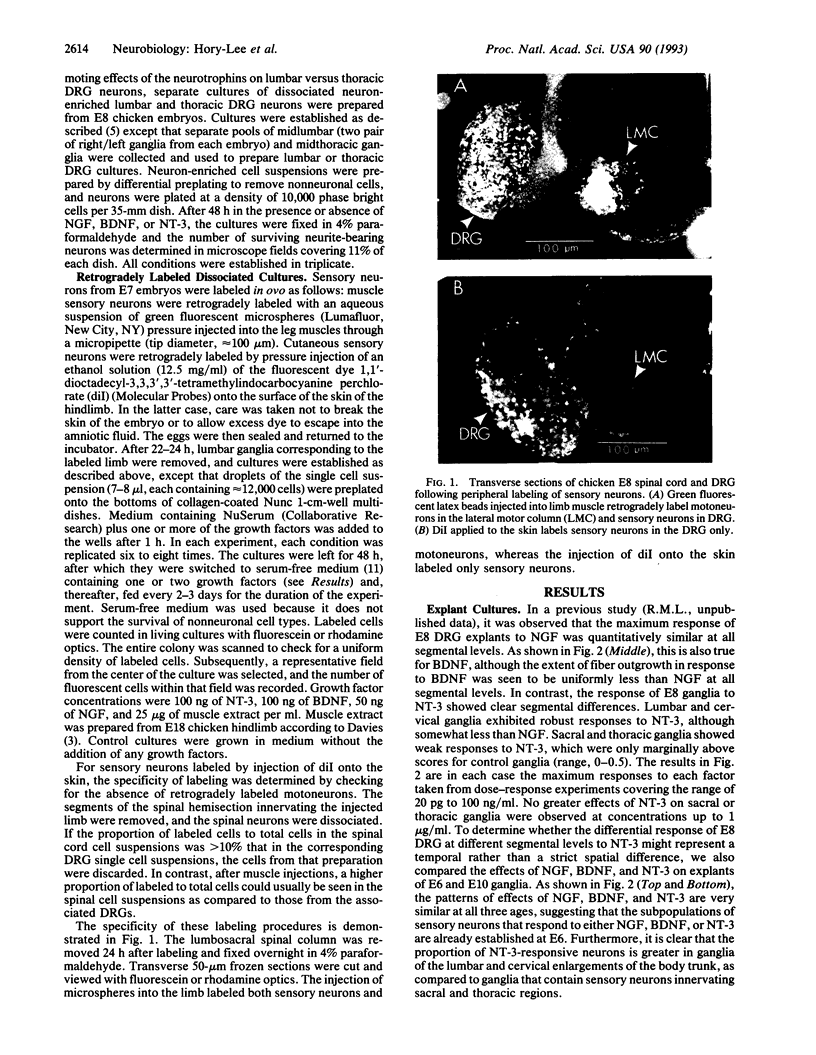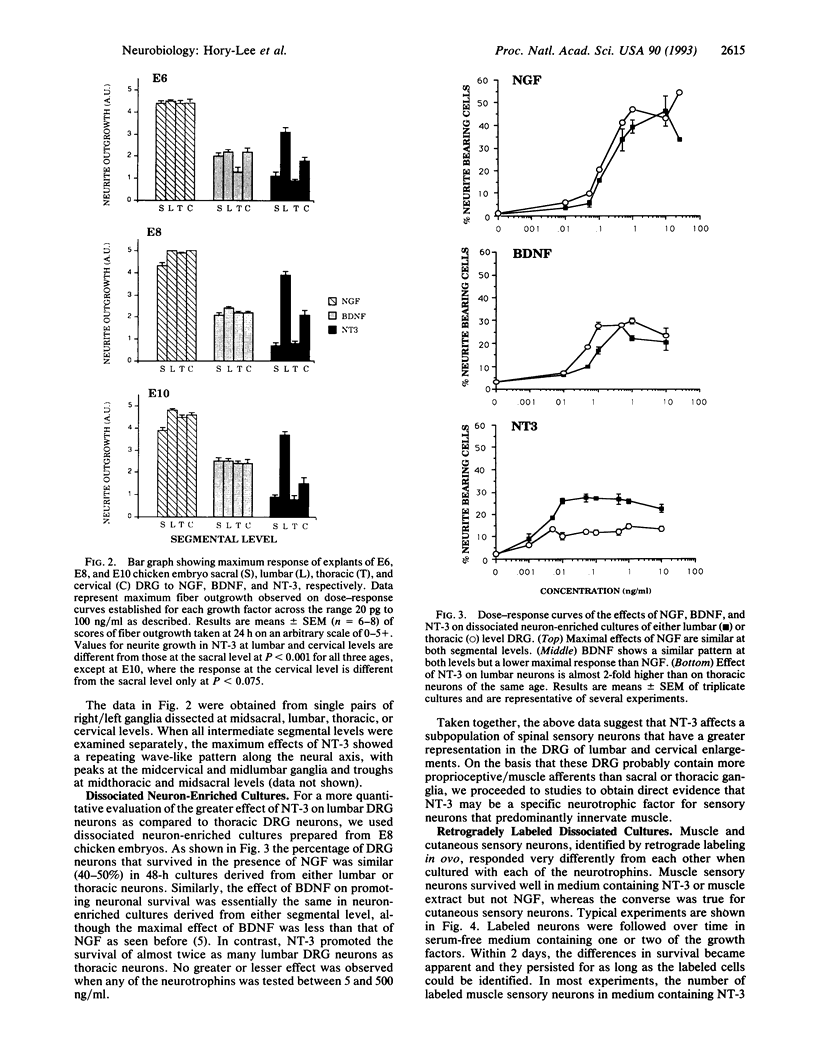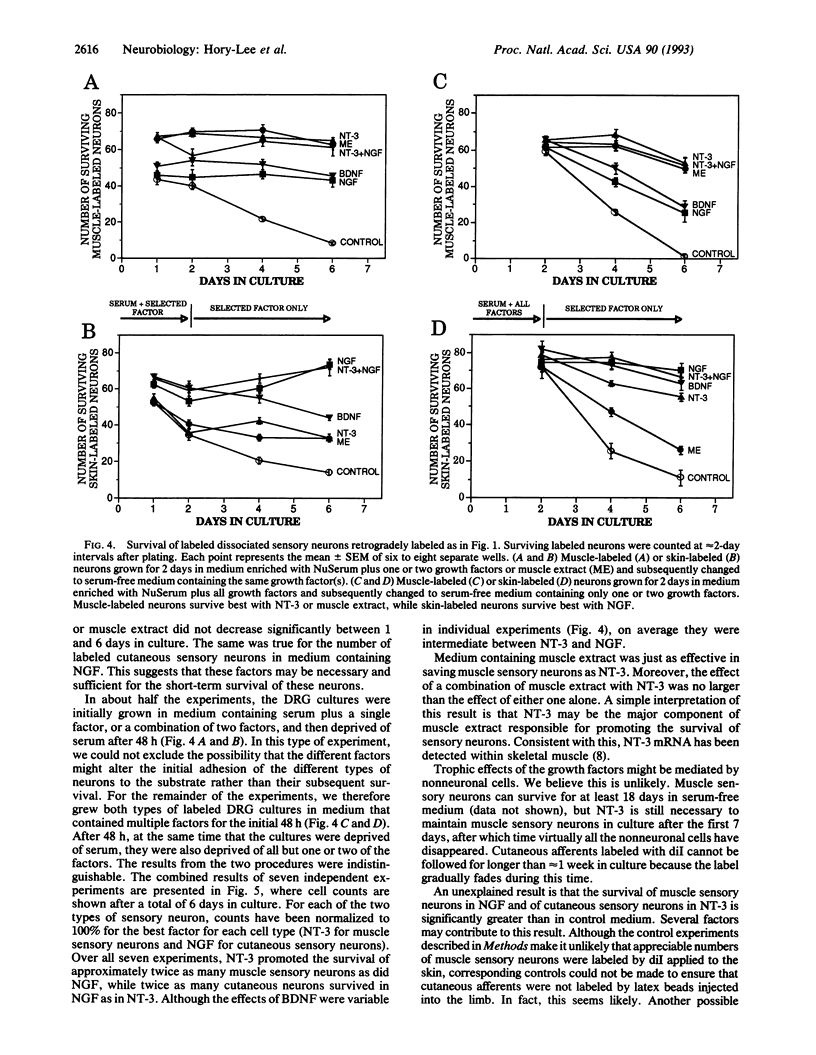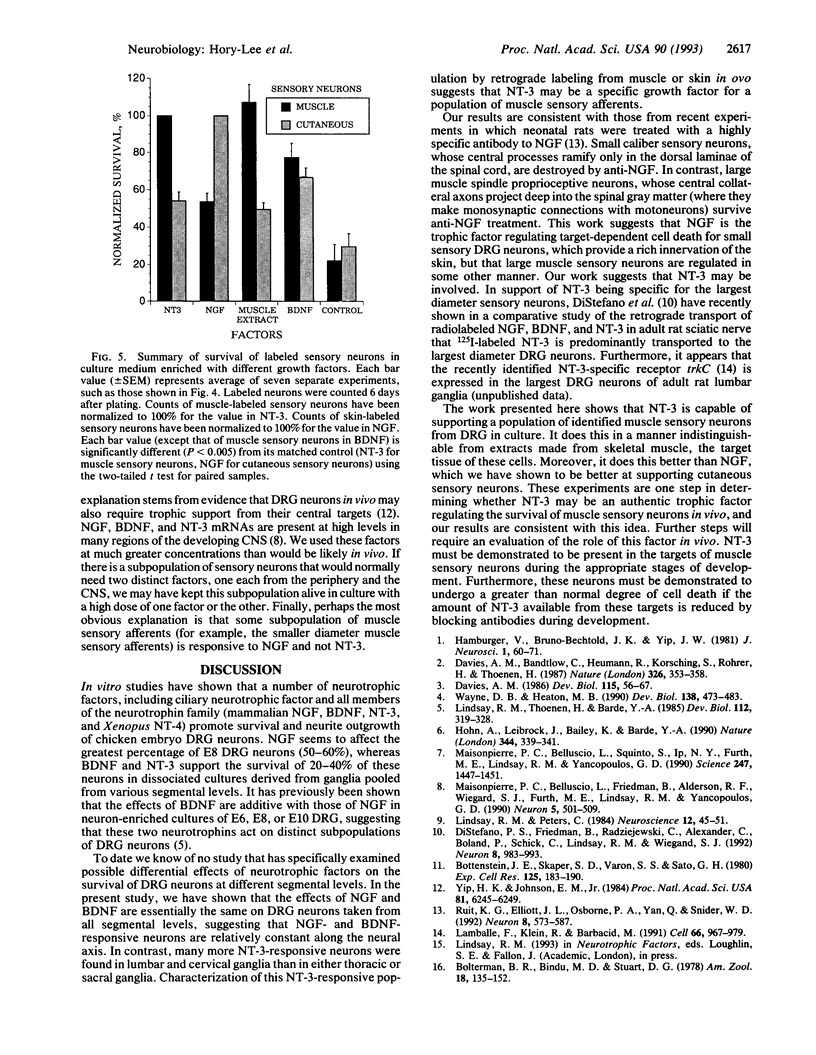Abstract
Target-dependent cell death of different sub-populations of sensory neurons may be regulated by different trophic factors. To investigate this possibility, we have taken advantage of the fact that the fractions of muscle sensory and cutaneous sensory neurons in chicken dorsal root ganglia (DRG) are probably different at different segmental levels, and we have compared the responses of chicken DRG from levels that do and do not innervate limb tissue to various growth factors in vitro. Nerve growth factor (NGF) and brain-derived neurotrophic factor (BDNF) both supported neurite outgrowth from DRG explanted from all segmental levels. In contrast, neurotrophin 3 (NT-3) supported robust neurite growth only from DRG explanted from the cervical or lumbar levels, which innervate limb muscles. Similarly, NGF and BDNF both promoted survival of dissociated neurons from limb and nonlimb segmental levels, whereas NT-3 promoted survival of more neurons from limb compared to nonlimb levels. This suggests that muscle sensory neurons, which are probably more prevalent at the cervical and lumbar levels, may be specifically affected by NT-3. To evaluate this possibility directly, we compared the survival of retrogradely labeled muscle and cutaneous neurons in NGF, BDNF, and NT-3. Identified muscle sensory neurons survived best in vitro in the presence of NT-3, while the survival of identified cutaneous sensory neurons was greatest in NGF. This work provides direct evidence for a potential role of NT-3 versus NGF in the survival of a specific subpopulation of DRG neurons.
Full text
PDF




Images in this article
Selected References
These references are in PubMed. This may not be the complete list of references from this article.
- Bottenstein J. E., Skaper S. D., Varon S. S., Sato G. H. Selective survival of neurons from chick embryo sensory ganglionic dissociates utilizing serum-free supplemented medium. Exp Cell Res. 1980 Jan;125(1):183–190. doi: 10.1016/0014-4827(80)90202-5. [DOI] [PubMed] [Google Scholar]
- Davies A. M., Bandtlow C., Heumann R., Korsching S., Rohrer H., Thoenen H. Timing and site of nerve growth factor synthesis in developing skin in relation to innervation and expression of the receptor. 1987 Mar 26-Apr 1Nature. 326(6111):353–358. doi: 10.1038/326353a0. [DOI] [PubMed] [Google Scholar]
- Davies A. M. The survival and growth of embryonic proprioceptive neurons is promoted by a factor present in skeletal muscle. Dev Biol. 1986 May;115(1):56–67. doi: 10.1016/0012-1606(86)90227-7. [DOI] [PubMed] [Google Scholar]
- DiStefano P. S., Friedman B., Radziejewski C., Alexander C., Boland P., Schick C. M., Lindsay R. M., Wiegand S. J. The neurotrophins BDNF, NT-3, and NGF display distinct patterns of retrograde axonal transport in peripheral and central neurons. Neuron. 1992 May;8(5):983–993. doi: 10.1016/0896-6273(92)90213-w. [DOI] [PubMed] [Google Scholar]
- Hamburger V., Brunso-Bechtold J. K., Yip J. W. Neuronal death in the spinal ganglia of the chick embryo and its reduction by nerve growth factor. J Neurosci. 1981 Jan;1(1):60–71. doi: 10.1523/JNEUROSCI.01-01-00060.1981. [DOI] [PMC free article] [PubMed] [Google Scholar]
- Hohn A., Leibrock J., Bailey K., Barde Y. A. Identification and characterization of a novel member of the nerve growth factor/brain-derived neurotrophic factor family. Nature. 1990 Mar 22;344(6264):339–341. doi: 10.1038/344339a0. [DOI] [PubMed] [Google Scholar]
- Lamballe F., Klein R., Barbacid M. trkC, a new member of the trk family of tyrosine protein kinases, is a receptor for neurotrophin-3. Cell. 1991 Sep 6;66(5):967–979. doi: 10.1016/0092-8674(91)90442-2. [DOI] [PubMed] [Google Scholar]
- Lindsay R. M., Peters C. Spinal cord contains neurotrophic activity for spinal nerve sensory neurons. Late developmental appearance of a survival factor distinct from nerve growth factor. Neuroscience. 1984 May;12(1):45–51. doi: 10.1016/0306-4522(84)90136-2. [DOI] [PubMed] [Google Scholar]
- Lindsay R. M., Thoenen H., Barde Y. A. Placode and neural crest-derived sensory neurons are responsive at early developmental stages to brain-derived neurotrophic factor. Dev Biol. 1985 Dec;112(2):319–328. doi: 10.1016/0012-1606(85)90402-6. [DOI] [PubMed] [Google Scholar]
- Maisonpierre P. C., Belluscio L., Friedman B., Alderson R. F., Wiegand S. J., Furth M. E., Lindsay R. M., Yancopoulos G. D. NT-3, BDNF, and NGF in the developing rat nervous system: parallel as well as reciprocal patterns of expression. Neuron. 1990 Oct;5(4):501–509. doi: 10.1016/0896-6273(90)90089-x. [DOI] [PubMed] [Google Scholar]
- Maisonpierre P. C., Belluscio L., Squinto S., Ip N. Y., Furth M. E., Lindsay R. M., Yancopoulos G. D. Neurotrophin-3: a neurotrophic factor related to NGF and BDNF. Science. 1990 Mar 23;247(4949 Pt 1):1446–1451. doi: 10.1126/science.247.4949.1446. [DOI] [PubMed] [Google Scholar]
- Ruit K. G., Elliott J. L., Osborne P. A., Yan Q., Snider W. D. Selective dependence of mammalian dorsal root ganglion neurons on nerve growth factor during embryonic development. Neuron. 1992 Mar;8(3):573–587. doi: 10.1016/0896-6273(92)90284-k. [DOI] [PubMed] [Google Scholar]
- Wayne D. B., Heaton M. B. The response of cultured trigeminal and spinal cord motoneurons to nerve growth factor. Dev Biol. 1990 Apr;138(2):473–483. doi: 10.1016/0012-1606(90)90213-3. [DOI] [PubMed] [Google Scholar]
- Yip H. K., Johnson E. M., Jr Developing dorsal root ganglion neurons require trophic support from their central processes: evidence for a role of retrogradely transported nerve growth factor from the central nervous system to the periphery. Proc Natl Acad Sci U S A. 1984 Oct;81(19):6245–6249. doi: 10.1073/pnas.81.19.6245. [DOI] [PMC free article] [PubMed] [Google Scholar]





